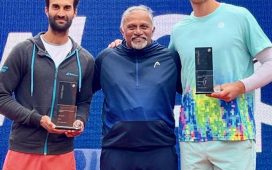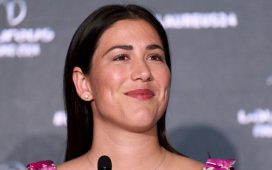Moments after losing a tight, gruelling first-round battle in the qualifying rounds of Wimbledon, Alexandra Cadantu silently exited the court alone, her head bowed and eyes clenched shut. She settled on a towel in the middle of the vast Roehampton field and picked up her phone to speak to her loved ones.
As the 29-year-old admitted, this was actually one of her least lonely losses in recent years – her father and manager had travelled to London and they were waiting in the wings to comfort her. But for every other week in the year, with her ranking of 205, the Romanian has no choice but to travel the world and suffer bitter defeats alone.
On Friday, the ATP player council met at Wimbledon to discuss prize money, the need to push tennis’s institutions to be more transparent over revenue and to better distribute money through the tiers of the game. Sergiy Stakhovsky, a member of the ATP council competing in Roehampton, places the onus on the ATP events rather than the slams.
“For a lot of guys, the money is an issue,” he says. “I do believe that the grand slams made a significant step in the right direction. I think that now it’s the turn of our own tour to make better conditions for the rest. The grand slams, they have increased [prize money] 300% in the past six years, which is a significant step. But the Tour didn’t do anything.”
In recent weeks the public debates over earning a living have focused on the men’s game and, while women enjoy equal pay at the slams, their plight lower down the rankings has been less visible. Cadantu was once a top-100 player dreaming of an even greater future. From 2011, she made the cut three years in a row. She climbed to a career high of world No 59 in 2014, but by the end of the year had to start over again after severe injuries including a six-centimetre abdominal rupture and surgery for a deviated septum.
Injured tennis players earn nothing, yet Cadantu had a coach to pay and bills to settle. She rushed back. Her body was vulnerable, so she quickly fell into a vicious circle of injuries. She would enter a series of tournaments, but after the first event her arms and legs would scream for mercy. Her ranking collapsed but the urge to play through the pain and recover losses locked her into the cycle. “That’s another thing a top player who has money or a sponsor would not do. But in my case I had to go because maybe I would win some money,” she says.
The world No 115 Ysaline Bonaventure qualified at Roehampton for the main draw at Wimbledon – and a guaranteed £45,000 even if she goes out in the first round. The 24-year-old Belgian explains that injured players are essentially working for free: “It is tough. You have to practise, you still have to pay your coaches, you have to pay the rent of your apartment. You have to pay a lot of things. It is tough that we don’t have any backup when we are injured.”
Vasek Pospisil, a member of the ATP player council whose ranking has fallen from 73 to 188 after eight months out with injury, recently suggested that it costs him $300,000-$400,000 per year to travel with a coach and physio for 30 weeks. Cadantu has travelled to 13 different tournaments this year, including three different trips to Asia where the easier competition offers more opportunities but costs more. Until Wimbledon, she had only earned $16,913 (£13,322).
The drastic disparity in prize money between tournaments only adds further pressure, with a player’s performance at the four slams defining whether they will earn enough money for the year or suffocate in debt. Cadantu earned a paltry $126 (£99) after winning a qualifying round in a low-tier event in Singapore this January, while she would have matched Bonaventure’s £45k with three at Roehampton.
Cadantu’s struggles pushed her to the edge and she eventually set up a GoFundMe in August last year, asking fans to help her return to where she once was. “Everything is difficult,” she says. “You have to travel yourself and it’s not easy when everyone else is with coaches, physios and a team [and] you have to manage yourself, to think all the time about the flight tickets and how to get the cheapest hotels or food.”
Across the Roehampton grounds, the 27-year-old Danielle Lao sliced her way through to the final qualifying round for the first time. Unlike most of her peers, Lao’s journey began after an illustrious college tennis career at the University of South Carolina. In college, tennis is a team sport and as Lao transitioned to the tour, she struggled with both the responsibility and the reality of being alone.

With her degree in communications and business, there was the promise of a far more lucrative job if she really wanted it. She did not, at least not yet. Instead, Lao was so broke when she started that she could not afford a coach. In the end, the American met with her childhood coach, Kal Moranon, and they came to an agreement.
“He said: ‘You still have a love for the game and I want to help you out, so let’s finish this. You don’t have to pay me until you make money. So come, let’s hit balls, let’s work on your game and then we can get lunch.’” And so, for the first few years, Lao paid her coach with lunch. Without him, she says, her professional career probably wouldn’t have left the ground.
So many promising players are scuppered by financial ruin. For Lao, the past five years have seen a long, steady arc of improvement. At 5ft 3in and 115lb, the Californian is tiny and slight.
She calls herself “The Little Giant”, a constant reminder to play bigger than she is, to be more creative. “Everything needs to be a bit more perfect [for me],” she explains. “I have to hit clean. There’s really not too much room for error for me. If I hit the ball a little off centre, I’m going to miss it because there’s just so much power behind their ball.”
Her time on the practice court has been spent building a game to counter power with slice, spin and the wherewithal to outthink opponents attempting to bludgeon her off the court.
In the summer of 2016, Lao considered retirement. She was not improving, injuries were constant and she was haemorrhaging money. In December 2017, she flew to Australia anticipating that enough players would withdraw for her to make the cut for the qualifying draw at the next year’s first grand slam. She missed it by one spot, and as the alternate had to watch other players win and lose as she earned nothing. For Lao, aside from it funding much of her year, the utility of slam first-round prize money is that it allows her to travel more with her coach. For Cadantu the struggle goes on alone.








